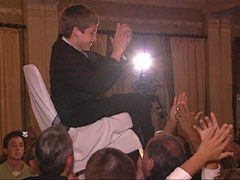In This Episode << SLIDE LEFT TO SEE ADDITIONAL SEGMENTS
Greener Bar Mitzvah
RABBI LAWRENCE TROSTER (GreenFaith): To be bar-mitzvahed is to come of age in the Jewish tradition. For women, it’s bat mitzvah. Many years ago, the rabbis had to create, what you might say, a legal definition of what it meant to be an adult, and they picked twelve for a girl and thirteen for a boy, and in the last few hundred years this has become really a rite of passage in our communities, a way to publicly proclaim that this person is now an adult member of our community, and we do that symbolically by calling them to the Torah, to have them read a Torah portion. It means that we are now fully responsible for our actions, that we are part of the covenanted community, that we are expected to live up to the Jewish tradition. In other words, a child is not culpable for things they don’t do or do wrong, but an adult is.
I think it is a good fit that we use the bar mitzvah or the bat mitzvah as a way to inculcate environmental values. Protecting the earth is a mitzvah, and I mean this in the sense of a commandment. In other words, that we are commanded, we are required, to take care of creation. It’s not a choice.
 ANNA HACKMAN (Bar Mitzvah Mother and Editor, GreenTalk.com): This is my third bar mitzvah—I have four sons—and I took a look at this bar mitzvah for more of a carbon footprint, like what was I doing that was impacting the Earth, that I could make a difference?
ANNA HACKMAN (Bar Mitzvah Mother and Editor, GreenTalk.com): This is my third bar mitzvah—I have four sons—and I took a look at this bar mitzvah for more of a carbon footprint, like what was I doing that was impacting the Earth, that I could make a difference?
One of the most important parts is the tallis. It’s something that he wears during the service. It’s something he’s going to have his whole lifetime. It’s made out of organic cotton. It was hand-woven, and it symbolizes things about him, and his yarmulke was made by Guatemalan women that actually are paid fair-trade wages, and these wages help support their families. The other yarmulkes, I had them made out of hemp, and they’re all lined with organic cotton.
At the service there’s a program. It’s all made out of 100 percent recycled paper. The invitation’s a Web site with places for people to RSVP. It’s got pictures of Jacob. It’s got polls and quizzes, and the best thing is there’s no paper being used. There’s nobody mailing things back and forth to me. On the invitation, I put a note on the bottom to please try and carpool to cut down on the consumption of natural resources.
The theme is a movie theme, so what I did is I went and bought used DVDs as place markers for everybody to pick up when they come and look for their tables, so it’s something that they could take home and watch. They’re not going to throw it in the trash like a little paper, you know, place card.
We chose to put on the tables soy candles that are a renewable source, and they burn much cleaner. There’s not toxic chemicals coming from, like, wax candles.
The centerpieces are actual plants that are going to be planted in my garden. I made sure that they were ones that would live, so nothing’s wasted.
We’re serving three different meals. Everything was sourced either locally or was and/or organic. The leftover food is composted, or the balance of the food is donated to a food pantry.
The dress that you can see that I’m wearing, it’s a consignment dress. People wear dresses once for bar mitzvahs, and to me it’s senseless.
My goal to make this bar mitzvah greener is to let the world know that they can do it, being able to take my religion and say yeah, I’m part of that. It’s just another connection for me that makes me feel more vibrant as a Jew.

